To embrace openness by unlocking simple yet routine processes, e.g. the assignment of office supplies
Here’s the essence of our hack:
Start 'under the radar', with something 'harmless', wait for results, involve volunteer/ staff in hosted conversations to plan these 'skunkworks', wait for it to go viral. Be prepared to have a small 'slap on the wrist' every now and then, but show with good humour how engagement and productivity have increased.
The day is coming…
You know it is coming. It’s not a secret, not anymore. As the economy shifts from knowledge to creativity, and as your kids teach you how to reconnect to the world, openness gains muscle as a principle of what is now called management 2.0.
You’ve been training for this day. You already have a sense of what it is to be transparent. The zen is emerging inside of you. You have read it all. You know about Semco and Morningstar, and how Wikimedia sets its long term strategy out in the open.
“It’s time to do something here”, you say as you hit the clock in the lobby. You’re determined. So, you are now heading into that office, the big one in the corner with a unique and breathtaking view. You are finally announced, and there you are, sharing with excitement your epiphany about how the company can embrace this new worldview.
But then… (you know what’s going to happen, do you?), that look! You get that look, which tells you loud and clear: “I’m not interested, I’m about to yawn and all I hear from you is: repent. The end is near! Blah, blah, blah…”
Fullback, it’s time to retreat and here’s when you hear: “… and please, close the door when you leave the room.”
That’s closed-ness speaking and scoring a goal, again!
Yes, the playing field needs to be leveled. But for now, you are in the conference room, all by yourself, muttering: “how can I inject at least a little doze of openness in our culture?” Ignoring that, maybe, just maybe, within your very question lays a simple yet powerful answer.
FIRST PART: INTRODUCTION
So, what’s going on? How to tackle this situation? Let’s dig for some theory to unveil the solution.
Openness is…
It is a frame of mind, a discipline to a certain extent. It is about establishing and nurturing relationships with others based on honesty, humility, interdependence, and trust.
To become an openness grandmaster, it is required to follow some rules:
- Learn the basics, its ABC
- Unlearn some preconceptions, and
- Practice, practice a lot (including making tons of mistakes)
So far so good, right? You are already an avid student. You’ve seen and experience things, and you’re gradually realizing that losing some control is not that bad after all.
But, what about those around you? What about the organization where you spend most of your days? Do they have “seen” what you have, or is there a chance they are devoted black belts of the path of… secrecy?
Closed-ness is also…
It is a frame of mind, a discipline to a certain extent. It is about controlling and hoarding information based on a “confidentiality” policy, supposedly for the benefit of the organization. To dominate it at full is also required to:
- Learn the basics, its ABC (aha, and we know them very well!)
- Unlearn some preconceptions (preconceptions, what’s that?), and
- Practice, practice a lot (we’ve been training since kindergarten or earlier)
The truth is we are all expert players of a closed-ness game. It is also true that both, closed-ness and openness are situational and they complement each other in a fragile (yin and yang) balance.
And Here Comes the Trick
Once a discipline is acquired, it is really very hard to unlearn it (or to turn it off momentarily). Hence, is it possible a change of philosophy? Is it possible to drive a company from closed-ness to openness? Of course it is, but not overnight.
SECOND PART: SOLUTION
Clip by Clip, Literally
The path for a complete openness could begin little by little. You just need to locate a simple yet routine, and most importantly, relevant-to-the-employee (e.g. annoying) process, and let people take full control of it, the simpler the better. Look for mundane processes, such as vacation periods, sick leave, time clock, travel expenses, office supplies, and on. This will help you operate under the radar as well as guide your organization step by step with a radical yet practical approach. As writers like to say: show, don't tell.
Once a process has been fully unlocked, find another simple yet routine process and repeat the experience.
Later, once you've seen success opening up routines, you can tackle bigger and scarier projects. Unlock more complex processes. Unlock your strategy, your company, your industry and beyond!
THIRD PART: PREPARATION
Now, roll up your sleeves because it’s time to hack! But don’t worry, you won’t be alone. We are going to explore together one of the simplest yet intricate and fiercely controlled processes someone can found. We are talking about assigning office supplies.
Have you been trapped in a complex Web of bureaucracy just because you need a pencil or a stapler? We certainly have, and more than once.
So, let’s unlock it and learn through this example how the Open Up Clip by Clip principles can be applied in other processes, too.
Boundaries of Openness
Is your organization prepared to experience small changes? One way to figure it out is by testing the actual stage of your company’s culture. Here’s a free survey designed by the authors of Tribal Leadership that you may find quite useful: http://www.triballeadership.net/culture-meter
In addition, you can ask people -especially the ones involved/affected in the process of office supplies- what words come first into their minds when they hear the following:
- Hacker
- Hack
- Disrupt
- Bottom-up
- Wisdom of crowds
- Free is a business model
This would give you a sense of how big the challenge is and how bumpy the ride will be.
Locking/Unlocking Levels
The next step is to identify how “locked” the process is and how much it will be opened. Normally, in traditional organizations settings, any office supply requisition must be approved by at least one level of authority and the process is monitored in a confidential manner. Thus, you need to have a proper clearance to be able to see supply trend consumptions (including yours). The idea is that you and your company manage to go step by step in a ladder of settings, just as follows, moving from a traditional to a non-traditional environment:

Consider that in non-traditional settings, tracking may be important and useful to publicly or collectively measure, and therefore, provide a quality service. By knowing how many office supplies are spent, the company will be able to restock them on time, improve procedures and keep employees satisfied.
In this sense, the proposed setting should give people full autonomy so that anyone can feel comfortable of taking any office supply whenever they want and in the quantities they need. The solely condition is to publicly declare or share (with the help of an open inventory management tool) their consumption decisions.
Here’s a comparison of both settings, which shows how simple the office supply process could be:
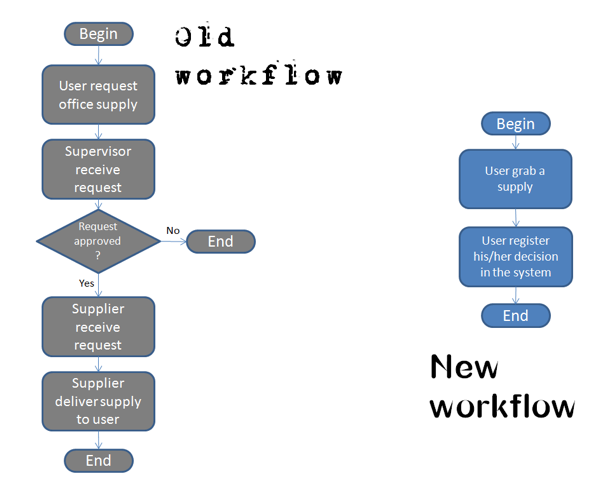
Note: data could be anonymously tracked if you consider it might help your experiment. Also, for further steps, if you believe your company is prepared, let the office employees decide on how the money for office supplies are spent, for example, or even eliminate (if it is not that necessary for you) the tracking feature. You will be escalating the path of openness.
“Class, Close Your Books, It's Time for a Quiz”
So far, we have identified the starting setting of the process and how in the near future its configuration will look like. At this point, it will do no harm to perform a quick test using these guiding questions:
- Is this new setting more transparent? (Y/N)
- Does it remove layers of bureaucracy? (Y/N)
- Does everyone get clear and tangible benefits? (Y/N)
Whatever the answers may be, they will point out what purpose the unlocked process actually serves. For example, if you said “yes” to all three questions, then, congratulations! It is likely that good things will come from your open design. On the contrary, if one or more answers resulted as negative, it may be required to rethink your non-traditional setting. Otherwise, you may just be building a rather big brother-esque new way to surveillance things around, and this, as you may agree, could be disastrous.
Of all three questions, the last one is perhaps the most important. Openness is not necessarily a zero sum game. Everyone can win, even status quo, which at first glance appears to “lose” its power. To illustrate this, let’s imagine some of the immediate benefits in the people normally involved in the office supply process after applying OUCC (with no approvals and with a public tracking feature):
- The user: gets instantaneous gratification and feels trusted by the status quo.
- The supervisor: reduces mental fatigue and saves time. As David Allen describes (see Dave Logan’s article), “when you look at a piece of paper, a report, an email, or anything else. Your brain asks: ‘What is this?’ You have to make a decision -- increasing decision fatigue.”
- The supplier (one who delivers office supplies and controls inventory): has a way to make the work easier that could allow him/her perform more productive and rewarding roles.
A Call for (Collaborative) Help
Now that you have passed the exam and already have in your mind a solid design for a simple and opened process, it is time to ask for some support. The best place to find it is in the front line! Go there (if you aren’t already there) and talk with everyone, especially with the younger ones, those entry levels and interns full of passion, ingenuity, energy, and odd ideas. They might be the openness black belts that you are looking for. So, get to know them (if you don’t know them yet), listen, listen carefully, and share with them this master plan you’ve been thinking about. Be generous. Give them your notes, your doodles, even your doubts, but especially, share with them your epiphany about how things can change for good in the near future. Make them dream!
Notice that from that very moment, your fabulous hack will be no longer yours. It will become a joint adventure and your role will be slowly drifting from a “manager” to a “host.” That’s precisely the kind of leadership current organizations need. Of course, it won’t be easy. Your courage will be tested and you will resemble less to Luke Skywalker and more like Yoda (although a bit taller).
All in all, offer volunteers an opportunity to open processes. Then, stand back and wait to be surprised. If you are sincere, you certainly will be rewarded with significant advantages.
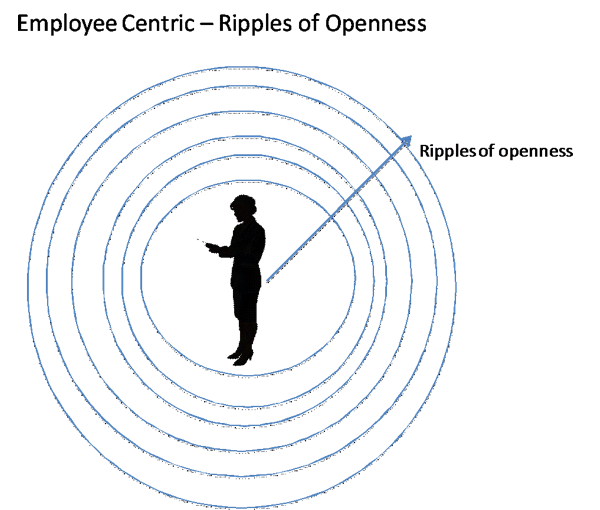
Introducing the Grab n’ Tell System
Previously, we talked about an open inventory management tool that users could use to publicly declare or share their supply consumption decisions. Well, we have designed a nice prototype for you! Although we like to call it the Grab n’ Tell Autonomy System, you may called differently if you want. It’s all yours. Feel free to download it, explore and modify it. That’s our little gift to you and your community. Below, it’s a screenshot for you to have a visual idea.
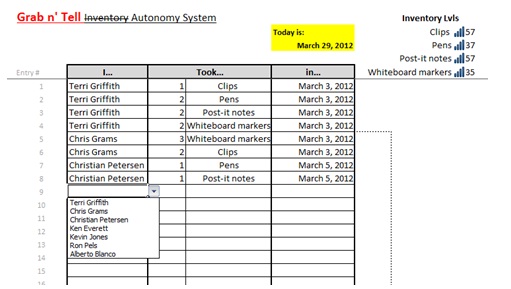
Additionally, find some general information about tool configuration and usage:
It's an Excel sheet (full of formulas!). So, you will find a first Grab n' Tell sheet, where you can play by adding or deleting names, quantities and chosen office supply. Note that this tool is programmed for seven users and four items (it can be changed). Next, you will also see an inventory estimation in the second sheet that will actually measure current consumption (green color turns into red when levels are too low). Finally, the following sheets in red show different graphics, figures, tables, etc. representing the changes in the registry. However, you have to click the red button (upper left corner in the "Total_Consumption" sheet) to refresh all the data.
The Open Window Effect
As Malcolm Gladwell describes in his best seller Tipping Point -How little things can make a big difference-, context has a tremendous power in spreading an idea. He argues, for example, that crime in New York significantly declined in the mid-nineties thanks in part of a…
“… cleanup of the subway system conducted by the New York City Transit Authority in the late eighties and early nineties. Why was the Transit Authority so intent on removing graffiti from every car and cracking down on the people who leaped over turnstiles without paying? Because those two "trivial" problems were thought to be tipping points-broken windows-that invited far more serious crimes.”
Hence, a good strategy to send a clear message that openness will be part of the process now is by doing some “trivial cleaning” in the office environment. Here are two suggestions that you might find useful:
- Make all data transparent: upload the Grab n' tell tool in the intranet so anyone can have access to it. This could help you promote peer-pressure (or should we say... community noble cause) rather than boss-pressure as the new way of control.
- Unlock the cabinet: open the office supplies cabinet and throw away the key (let go off the control you hold and be vulnerable). In addition, put a computer terminal nearby in order to make the grab n' tell procedure easier.
FOURTH PART: EXECUTION
Ready, Set, Go!
Run the experiment for a while in order to gather data and experience. Here are three tactical tips to help you out:
- Under the radar: remember status quo has many eyes, and your mission as an in-the-trenches innovator is to instill small doses of openness into your corporate culture. If your team get it right and have a bit of patience, the new transparent way will tip, transforming the organization at its core.
- Don’t peek: avoid the temptation to monitor consumption. Step aside, trust, wait, and prepare to be surprised.
- Be the example: be accountable. If you need a supply, then, go to the cabinet and take it yourself. Don’t ask others to deliver what you need to your desk.
FIFTH PART: NEXT STEPS
The project is reaching its finale, congratulations! Here are some last thoughts to get you into the next level:
Share Results with Your Community and Decide What to Do Next
Analyze qualitative and quantitative data (check the Experimental Design section for further guidance) and target along with your hacking team the next process to be unlocked. Some provocative examples are:
- Vacation periods
- Sick leave
- Time clock
- Travel expenses
- Dress code
- IT equipment
- Bonus schemes
- Pension schemes
- Salaries
Gone wrong? Celebrate!
Did staplers “magically” disappear during the open cupboard period? Well, that’s great news too! Failure is the oxygen of every successful campaign. Those missing items are nothing more than a small price you’ve paid for realizing how urgently your corporate culture needs to be revitalized. We encourage you to start with the basics. It may be the appropriate moment to rethink the very essence of your business: its purpose and core values. You can try another experiment, refer to the MSS Hack.
Go Back to that Office… This Time, You’re Not Alone!
Some useful data, and most importantly, a community are backing you up. Now, it may (just may…) be easier to get attention for your ideas, including funding for large scale projects.
Retweet this!
Make this hack your movement, your voice. Personalize it as much as you want and carry this inspiring message wherever you go. If you like, go ahead and talk with us. We’d LOVE to hear from you!
- Open up decision making by unlocking one process at a time.
- Encourage transparency, autonomy, trust and accountability. In full flower, these are shown to increase innovation, productivity, and shared leadership, as well as to reduce frustration and, eventually, staff turnover.
- Eliminate control friction and cost.
- Evaluate current corporate culture.
- Improve corporate culture.
- Gradually embrace openness, one clip at a time, one process at a time.
- Enhance ROI and ROE.
It is important to note that employees will have the decision power and will be able to respond dynamically to new changes or new information.
The beauty of this approach is that it is experimental. The real question then is what to do if it succeeds....and the answer is just do more.
== Hypothesis ==
Small doses of openness produce positive impacts in both culture and efficiency.
== Measurement ==
This experiment will be measured by two categories: quantitative and qualitative.
QUANTITATIVE MEASURE
Before the experiment
Set up your open inventory tool: Grab n’ Tell tool took three days to be designed. Ask for help to your IT buddies if needed.
Steps:
a) Determine the minimum number of procedural tasks required to get an office supply with the locked process (i.e. five steps)
b) Determine the minimum number of procedural tasks required to get an office supply with the unlocked process (i.e. two steps)
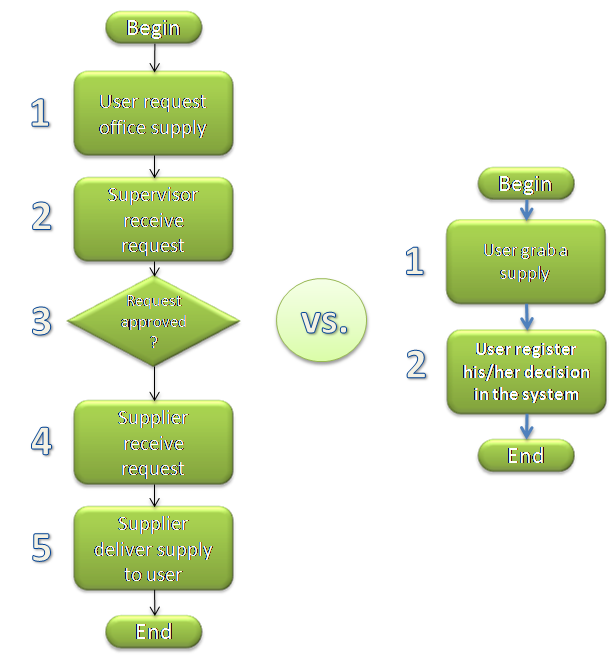
Time:
a) Determine the average number of minutes required to get an office supply with the locked process (i.e. 60 minutes)
b) Determine the average number of minutes required to get an office supply with the unlocked process (i.e. 10 minutes)
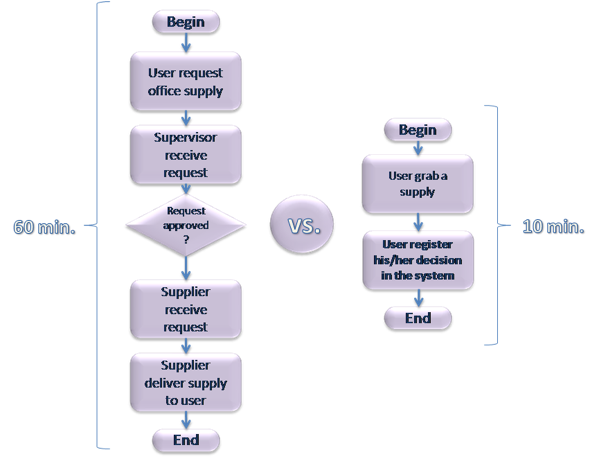
During the experiment
Consumption:
a) Register the number of supplies consumed by the control group during the time period of the experiment (i.e. register consumptions after 30 and 60 days)
b) Register the number of supplies consumed by the experimental group during the time period of the experiment (i.e. register consumptions after 30 and 60 days)
After the experiment
Compare Results: items consumed, steps taken, and time spent
The example below shows how an increment of 100% in supply consumptions (after unlocking the process) still results in a 67% of time saved.
On the other hand, if consumption trends remain the same in both groups (control and experimental) then, you will be saving more than 80% of time and 60% of steps taken with the application of the unlocked process.

On the other hand, if consumption trends remain the same in both groups (control and experimental) then, you will be saving more than 80% of time and 60% of steps taken with the application of the unlocked process.
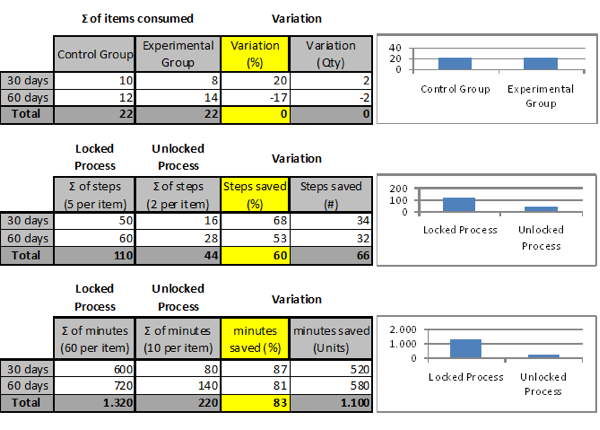
If you are curious (we are), then go for it. Start your own experiment and show us some cool ratios!
QUALITATIVE MEASURE
Now, this is the hard part. How to measure culture? Perhaps, it will be easier to observe changes in behavior and listen carefully to how people “talk” once the hack has finished. You can even invite participants to share their experiences and conclusions through stories. Also, if you want a scientific approach you can use or adapt that culture survey we talked earlier (check Boundaries of Openness section) and apply it (or you modified version) before and after the experiment. Later on, gather data and analyze participants score variations just as you we did above with the quantitative variables:
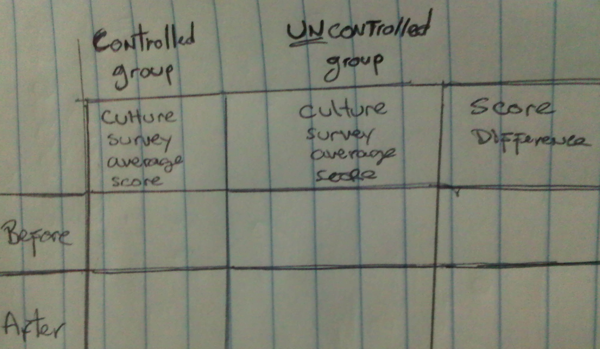
If you have a better strategy, please share it with us. On our side, we are going to work in this subject as well.
== Experimental and Contro Group ==
Look for two small departments or business units with similar characteristics. One of them will be the control group and the other one will be the experimental group.
== Timeline ==

This hack has been proudly developed during the MIX Management 2.0 Hackathon by seven innovative minds:
Alberto Blanco
Ken Everett
Chris Grams
Terri Griffith
Kevin Jones
Ron Pels
Christian Petersen
Apart from this, Alberto also wants to thank Diana Felibert for her unbelievable contribution in helping create Open Up Clip by Clip (from its title and initial ideation to the final x-ray editing)
<<New>> Useful Resources!
Birkinshaw, J., & Cohen, J (2013, September). Make Time for the Work that Matters. Retrieved on September 25, 2013, from https://archive.harvardbusiness.org/cla/web/pl/product.seam?c=28173&cs=89349d32f50c72dc6cc039340006d09e&i=28175




You need to register in order to submit a comment.